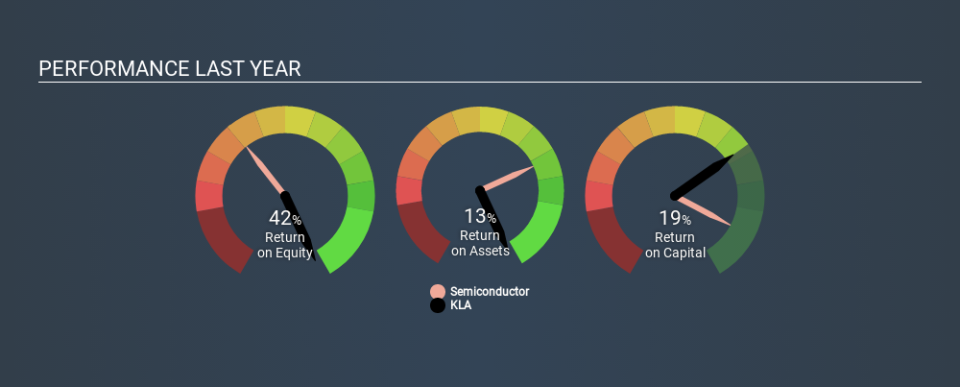Why You Should Like KLA Corporation’s (NASDAQ:KLAC) ROCE

Today we'll evaluate KLA Corporation (NASDAQ:KLAC) to determine whether it could have potential as an investment idea. Specifically, we're going to calculate its Return On Capital Employed (ROCE), in the hopes of getting some insight into the business.
First, we'll go over how we calculate ROCE. Then we'll compare its ROCE to similar companies. And finally, we'll look at how its current liabilities are impacting its ROCE.
Understanding Return On Capital Employed (ROCE)
ROCE is a measure of a company's yearly pre-tax profit (its return), relative to the capital employed in the business. Generally speaking a higher ROCE is better. Overall, it is a valuable metric that has its flaws. Renowned investment researcher Michael Mauboussin has suggested that a high ROCE can indicate that 'one dollar invested in the company generates value of more than one dollar'.
So, How Do We Calculate ROCE?
The formula for calculating the return on capital employed is:
Return on Capital Employed = Earnings Before Interest and Tax (EBIT) ÷ (Total Assets - Current Liabilities)
Or for KLA:
0.19 = US$1.4b ÷ (US$9.2b - US$1.9b) (Based on the trailing twelve months to September 2019.)
So, KLA has an ROCE of 19%.
See our latest analysis for KLA
Is KLA's ROCE Good?
ROCE is commonly used for comparing the performance of similar businesses. KLA's ROCE appears to be substantially greater than the 9.9% average in the Semiconductor industry. We would consider this a positive, as it suggests it is using capital more effectively than other similar companies. Regardless of where KLA sits next to its industry, its ROCE in absolute terms appears satisfactory, and this company could be worth a closer look.
We can see that, KLA currently has an ROCE of 19%, less than the 26% it reported 3 years ago. So investors might consider if it has had issues recently. The image below shows how KLA's ROCE compares to its industry, and you can click it to see more detail on its past growth.
It is important to remember that ROCE shows past performance, and is not necessarily predictive. Companies in cyclical industries can be difficult to understand using ROCE, as returns typically look high during boom times, and low during busts. This is because ROCE only looks at one year, instead of considering returns across a whole cycle. Future performance is what matters, and you can see analyst predictions in our free report on analyst forecasts for the company.
What Are Current Liabilities, And How Do They Affect KLA's ROCE?
Short term (or current) liabilities, are things like supplier invoices, overdrafts, or tax bills that need to be paid within 12 months. The ROCE equation subtracts current liabilities from capital employed, so a company with a lot of current liabilities appears to have less capital employed, and a higher ROCE than otherwise. To check the impact of this, we calculate if a company has high current liabilities relative to its total assets.
KLA has total assets of US$9.2b and current liabilities of US$1.9b. As a result, its current liabilities are equal to approximately 21% of its total assets. Low current liabilities are not boosting the ROCE too much.
What We Can Learn From KLA's ROCE
This is good to see, and with a sound ROCE, KLA could be worth a closer look. KLA looks strong on this analysis, but there are plenty of other companies that could be a good opportunity . Here is a free list of companies growing earnings rapidly.
If you are like me, then you will not want to miss this free list of growing companies that insiders are buying.
If you spot an error that warrants correction, please contact the editor at editorial-team@simplywallst.com. This article by Simply Wall St is general in nature. It does not constitute a recommendation to buy or sell any stock, and does not take account of your objectives, or your financial situation. Simply Wall St has no position in the stocks mentioned.
We aim to bring you long-term focused research analysis driven by fundamental data. Note that our analysis may not factor in the latest price-sensitive company announcements or qualitative material. Thank you for reading.

